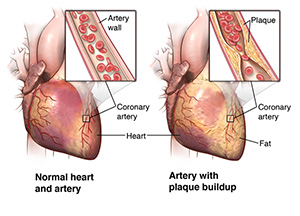What You Can Do to Prevent Atherosclerosis
What You Can Do to Prevent Atherosclerosis
Your good health has an enemy — atherosclerosis. Atherosclerosis is common. And its effects can be very serious. This condition can lead to strokes, heart attacks, and death. But, you can take steps to protect yourself from this disease.
What is atherosclerosis?
The inside walls of healthy arteries are smooth and clean. This makes it easy to transport the blood your body needs. But arteries can become clogged. Fatty substances like cholesterol can stick to artery walls. These deposits are called plaque. Plaque can eventually slow or block the flow of blood. This blockage is atherosclerosis. It can affect any artery in your body. When atherosclerosis affects the arteries that supply blood to the heart, it is called coronary artery disease. Two things may occur where a plaque develops. A plaque may break off or a blood clot may form on the plaque's surface. If either of these situations occur, it may lead to a blockage of an artery and ultimately a heart attack or stroke.
How is cholesterol measured?
The National Heart, Lung, and Blood Institute recommends that all adults older than 20 have their cholesterol level checked every 5 years. This is done with a blood test. The test should measure total cholesterol, LDL ("bad") cholesterol, HDL ("good") cholesterol, and triglycerides. Talk with your healthcare provider about your target cholesterol levels.
Am I at risk?
These factors put you at greater risk for atherosclerosis:
Smoking
High blood pressure
High cholesterol
A family history of atherosclerosis or heart disease
An inactive lifestyle
Overweight or obesity
Diabetes
Having more than one risk factor can increase your risk even more. You can control most of the above risk factors. The following tips can help prevent atherosclerosis and improve your general health. If you have atherosclerosis, you may be able to stop it from getting worse.
Smoking
If you smoke, stop. Scientists have shown smoking damages the artery walls which can lead to atherosclerosis. This makes it easier for plaque to build up. Smoking is even more risky when you have other risk factors like high blood pressure or diabetes. If you want help quitting, talk with your healthcare provider. He or she has information on medicines, nicotine replacement products, and programs to make it easier. Also, avoid places where there is cigarette smoke. Research suggests that smoke from others can increase your risk of atherosclerosis.
Diet
Make changes to your diet. A diet high in saturated fat and cholesterol can raise your cholesterol levels. When you have high cholesterol, there may be more plaque to line artery walls and narrow your arteries. The American Heart Association recommends that you reduce the amount of meat, eggs, milk, and other dairy products in your diet. Check food labels to find the amount of saturated fat in a product. Also, avoid large amounts of salt and sugar. Be careful with processed foods like frozen dinners. They can be high in fat, sugar, salt, and cholesterol. Choose lots of fresh or frozen fruits and vegetables, lean meats and fish, as well as whole-grains like oats and whole-wheat. Choose unsaturated vegetable oils like canola oil instead of saturated fats like butter.
Exercise
Exercise regularly. Regular aerobic exercise can help fight atherosclerosis by reducing the amount of fat in your blood, lowering your blood pressure and cholesterol, and controlling your weight. It's never too late to start exercising. Brisk walking, swimming, and bicycling are good choices. It's OK to start slowly and work up to at least 30 to 40 minutes, 4 to 5 days a week. But before you begin, ask your healthcare provider's advice about what kind of exercise program is right for you.
Checkups
Get regular checkups. Have your healthcare provider check your blood pressure and cholesterol. High blood pressure can further complicate atherosclerosis by causing artery walls to harden and thicken. This condition is called arteriosclerosis. Talk about your health and your risk factors for atherosclerosis with your provider.
Diabetes
Control diabetes with your healthcare provider's help. People who have diabetes develop atherosclerosis more quickly. If you have diabetes, control your blood sugar level carefully.
Will I know if I have it?
Because symptoms appear only after the damage has been done, don't wait for symptoms to develop before doing something about atherosclerosis. Begin by making the above lifestyle changes even if you feel well.
Together, you and your healthcare provider can decide what steps you need to take to stay healthy.
Updated:
June 11, 2017
Sources:
2013 ACC/AHA Guideline on the Treatment of Blood Cholesterol to Reduce Atherosclerotic Cardiovascular Risk in Adults. Stone, N. Circulation. 2013, s1-84., 2013 AHA/ACC Guideline on Lifestyle Management to Reduce Cardiovascular Risk. Eckel, R. Circulation. 2013, pp. s1-45.
Reviewed By:
Holloway, Beth, RN, M.Ed.
